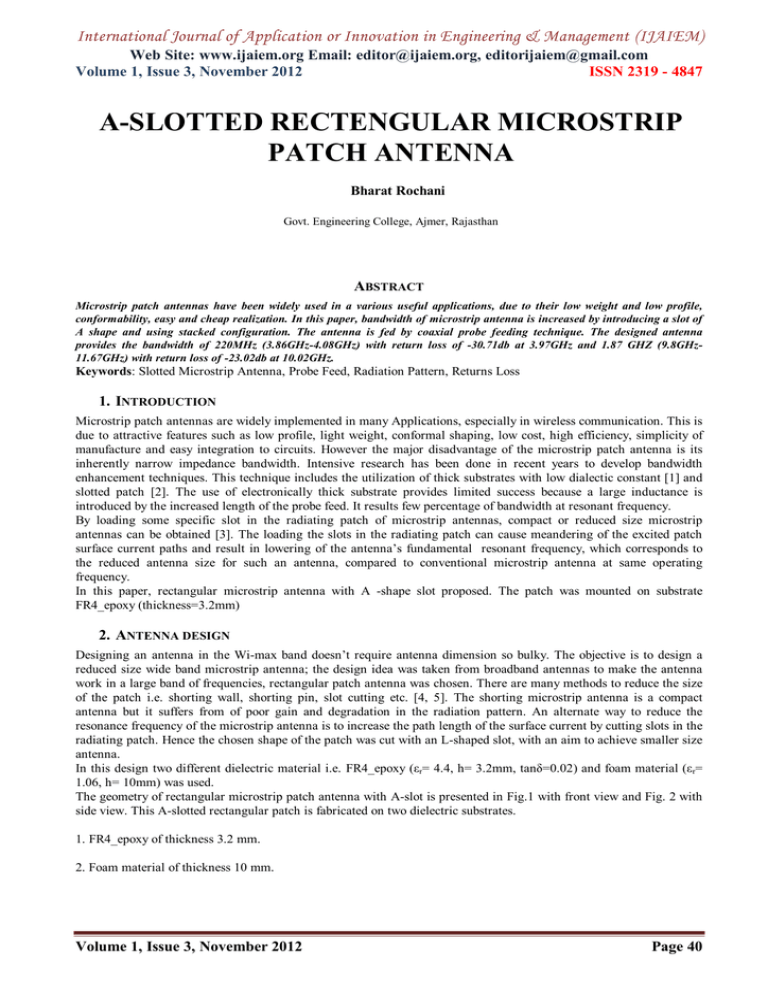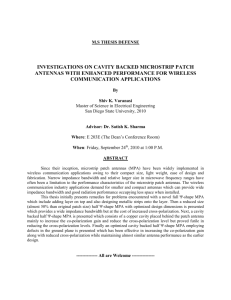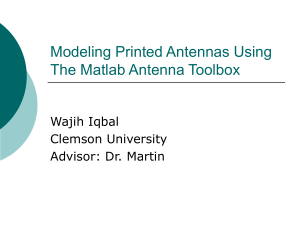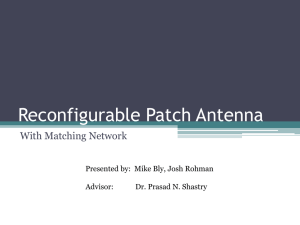A-SLOTTED RECTENGULAR MICROSTRIP PATCH ANTENNA Web Site: www.ijaiem.org Email: ,
advertisement

International Journal of Application or Innovation in Engineering & Management (IJAIEM) Web Site: www.ijaiem.org Email: editor@ijaiem.org, editorijaiem@gmail.com Volume 1, Issue 3, November 2012 ISSN 2319 - 4847 A-SLOTTED RECTENGULAR MICROSTRIP PATCH ANTENNA Bharat Rochani Govt. Engineering College, Ajmer, Rajasthan ABSTRACT Microstrip patch antennas have been widely used in a various useful applications, due to their low weight and low profile, conformability, easy and cheap realization. In this paper, bandwidth of microstrip antenna is increased by introducing a slot of A shape and using stacked configuration. The antenna is fed by coaxial probe feeding technique. The designed antenna provides the bandwidth of 220MHz (3.86GHz-4.08GHz) with return loss of -30.71db at 3.97GHz and 1.87 GHZ (9.8GHz11.67GHz) with return loss of -23.02db at 10.02GHz. Keywords: Slotted Microstrip Antenna, Probe Feed, Radiation Pattern, Returns Loss 1. INTRODUCTION Microstrip patch antennas are widely implemented in many Applications, especially in wireless communication. This is due to attractive features such as low profile, light weight, conformal shaping, low cost, high efficiency, simplicity of manufacture and easy integration to circuits. However the major disadvantage of the microstrip patch antenna is its inherently narrow impedance bandwidth. Intensive research has been done in recent years to develop bandwidth enhancement techniques. This technique includes the utilization of thick substrates with low dialectic constant [1] and slotted patch [2]. The use of electronically thick substrate provides limited success because a large inductance is introduced by the increased length of the probe feed. It results few percentage of bandwidth at resonant frequency. By loading some specific slot in the radiating patch of microstrip antennas, compact or reduced size microstrip antennas can be obtained [3]. The loading the slots in the radiating patch can cause meandering of the excited patch surface current paths and result in lowering of the antenna’s fundamental resonant frequency, which corresponds to the reduced antenna size for such an antenna, compared to conventional microstrip antenna at same operating frequency. In this paper, rectangular microstrip antenna with A -shape slot proposed. The patch was mounted on substrate FR4_epoxy (thickness=3.2mm) 2. ANTENNA DESIGN Designing an antenna in the Wi-max band doesn’t require antenna dimension so bulky. The objective is to design a reduced size wide band microstrip antenna; the design idea was taken from broadband antennas to make the antenna work in a large band of frequencies, rectangular patch antenna was chosen. There are many methods to reduce the size of the patch i.e. shorting wall, shorting pin, slot cutting etc. [4, 5]. The shorting microstrip antenna is a compact antenna but it suffers from of poor gain and degradation in the radiation pattern. An alternate way to reduce the resonance frequency of the microstrip antenna is to increase the path length of the surface current by cutting slots in the radiating patch. Hence the chosen shape of the patch was cut with an L-shaped slot, with an aim to achieve smaller size antenna. In this design two different dielectric material i.e. FR4_epoxy (εr= 4.4, h= 3.2mm, tanδ=0.02) and foam material (εr= 1.06, h= 10mm) was used. The geometry of rectangular microstrip patch antenna with A-slot is presented in Fig.1 with front view and Fig. 2 with side view. This A-slotted rectangular patch is fabricated on two dielectric substrates. 1. FR4_epoxy of thickness 3.2 mm. 2. Foam material of thickness 10 mm. Volume 1, Issue 3, November 2012 Page 40 International Journal of Application or Innovation in Engineering & Management (IJAIEM) Web Site: www.ijaiem.org Email: editor@ijaiem.org, editorijaiem@gmail.com Volume 1, Issue 3, November 2012 ISSN 2319 - 4847 Table 1: ANTENNA DIMENSIONS [6] S.No Antenna Parameters Specification 1 Length of the Patch (L) 40mm 2 Width of the Patch (W) 30mm 3 Height of the Substrate (h) 3.2mm 4 Height of the Foam (f) 10mm 5 Length of A slot arm(A1) 14.14mm 6 Width of Slot(A2) 5mm 7 Distance from Feed(F) 3.75mm W A1 L F A2 Figure 1 Top view of Slotted Rectangular Microstrip Patch Antenna h FR4_epoxy Patch Foam f Figure 2 Side View of Rectangular Microstrip Patch Antenna Where the length and width for the rectangular microstrip patch are following: The height of the patch is The width of the patch is W= The length of metallic patch L= Where Volume 1, Issue 3, November 2012 Page 41 International Journal of Application or Innovation in Engineering & Management (IJAIEM) Web Site: www.ijaiem.org Email: editor@ijaiem.org, editorijaiem@gmail.com Volume 1, Issue 3, November 2012 ISSN 2319 - 4847 & In this work, co-axial or probe feed technique is used as its main advantage is that, the feed can be placed at any place in the patch to match with its input impedance (usually 50 ohm). The software used to model and simulate the Aslotted rectangular patch antenna was HFSS 11 and used to calculate and plot return loss, radiation pattern. 3. RESULTS & DISCUSSION Figure 3 Return loss vs. Frequency curve for proposed antenna The analysis of the designed rectangular microstrip patch antenna was done by ‘HFSS 11’ software package based upon MOM technique. Return loss is the difference, in dB, between forward and reflected power measured at any given point in an RF system. The simulated plot of return loss against frequency is shown in Fig. 3. The return loss of -30.71db at 3.97GHz and -23.02db at 10.02GHz is obtained. The corresponding impedance bandwidth is 220MHz at 3.97 GHZ (5.54%) and 1.87 GHZ at 10.02GHz (18.66%) is obtained. Figure 4 Radiation Pattern The radiation Pattern with maximum gain of 6.34db is shown in figure 4. Volume 1, Issue 3, November 2012 Page 42 International Journal of Application or Innovation in Engineering & Management (IJAIEM) Web Site: www.ijaiem.org Email: editor@ijaiem.org, editorijaiem@gmail.com Volume 1, Issue 3, November 2012 ISSN 2319 - 4847 4. CONCLUSION In this paper, the small dual band for A slot microstrip patch antennas is designed. The parameters gain and return losses are shown. The probe feed technique and HFSS11’ [7] for simulation are used. The gain and return losses were good for these bands. The antenna is designed to be used in WiMax and multi-band applications. References [1] James, J.R. and Hall, P.S.: ‘Handbook of Microstrip Antennas’ (Peter Peregrinus) [2] Constantine A. Balanis, ‘Antenna Theory, Analysis and Design’ (John Wiley & Sons) [3] D.M. Pozar, "A reciprocity method of analysis for printed slots and slot coupled microstrip antennas", IEEE Transactions on Antennas Propagation. Vol. AP34, pp. 1439- 1446, December 1986. [4] Kin-Lu Wong, ‘Compact and Broadband Microstrip Antennas’ (John Wiley & Sons) [5] Ramesh Garg, ‘Handbook of Microstrip Antennas’ [6] Dinesh Yadav, “L-Slotted Rectangular Microstrip Patch Antenna”, 2011International Conference on Communication Systems and Network Technologies, June, 2011 [7] Ansoft Designer, www.ansoft.com. AUTHOR Bharat Rochani did his B.E. in Electronics and Communication Engineering from University of Rajasthan, Jaipur, Rajasthan. He is doing M.Tech. in Electronics and Communication at Govt. Engineering College, Ajmer, Rajasthan from Rajasthan Technical University, Kota, Rajasthan. His research areas are DIGITAL COMMUNICATION. Volume 1, Issue 3, November 2012 Page 43




